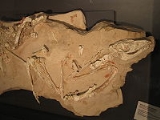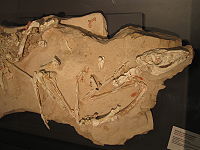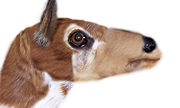
Poebrotherium
Encyclopedia
Poebrotherium is an extinct genus of terrestrial
herbivore
the family
Camelidae, endemic to North America
from the Eocene
through Oligocene
38—30.8 mya, existing for approximately .
 Poebrotherium was first named by scientist Joseph Leidy
Poebrotherium was first named by scientist Joseph Leidy
in 1848, and its relationship to other White River
fossils was later expanded by him in 1853. Fur trapper Samuel Culbertson was working in Nebraska
in pursuit of fur bearing mammals, and found a collection of strange fossil animal bones. He sent a box of these bones to his family back east, and not knowing what to make of them, they forwarded the remains to Leidy for identification. Several animals' remains were included in this package, but one of the most interesting was that of a small mammal, about the size of a small deer or sheep. In addition to a partial skull, a portion of a forelimb was found. The portions that Leidy was able to examine helped him determine it was likely related to modern llama
s, even though there was a paucity of new material available after his 1848 diagnosis. This package spawned Leidy's interest in the White River badlands and its fauna, and he eventually sent collectors from the American Museum west to expand his collection. Between 1848 and 1853, cases of new material were shipping back to Leidy, but maddeningly only three more Poebrotherium tooth samples were among the remains recovered.
Poebrotherium chadronensis can be translated to "grass-eating beast from Chadron [formation]"
Poebrotherium franki can be translated to "Frank's grass-eating beast"
 Poebrotherium looked more like modern camels than its predecessor Protylopus
Poebrotherium looked more like modern camels than its predecessor Protylopus
, but at 90 centimetres (3 ft) in height, it was roughly the size of a modern sheep. Its skull
resembled that of a modern llama
, while its limbs ended in hooved
toes and were more built for speed than the feet of Protylopus. Despite this apparent adaptation to the open plains, Poebrotherium has been found in all major White River
environments, including forests and river overbank deposits, indicating that it was not tied to one particular environment. The teeth of Poebrotherium were more generalised than those of modern camelids. In fact, despite the name meaning "grass-eating beast" it is likely that Poebrotherium was either a browser or a mixed-feeder, and grass may have played a minimal role in the diet of Poebrotherium.
 Unlike its modern cousins, which are either adapted for desert or alpine conditions, Poebrotherium took the place of a gazelle
Unlike its modern cousins, which are either adapted for desert or alpine conditions, Poebrotherium took the place of a gazelle
or deer
in the White River Fauna
ecosystem. This trait was taken to an extreme in later camels, notably Stenomylus
. Fossil evidence has shown that Poebrotherium was a popular prey item for the entelodont
Archaeotherium
. Remains of partial Poebrotherium carcasses have been found fossilized, and appear to have been killed and cached by Archaeotherium, the only animal known from the White River ecosystem that could have made the feeding marks found on the bones of Poebrotherium.
Camelidae, which can be defined as (Stenomylinae + (Miolabinae + (Protolabinae + Camelinae
))) + Poebrotherium. As such, Poebrotherium lies outside the Camelinae
proper. In fact the definition of Camelidae is the most recent common ancestor of Poebrotherium and Camelus
, and all of its descendants.
Several authors offer characteristics to define Poebrotherium. These include a long neck, an adult height of around 100 centimetres (3.3 ft), relatively unspecialized teeth, moderately long legs, long, unsplayed, unfused, and proximally wider-than-deep metapodials, a pes lacking digits 1, 4, and 5, and a typical ungulate
stance but lacking in a foot pad.
Terrestrial animal
Terrestrial animals are animals that live predominantly or entirely on land , as compared with aquatic animals, which live predominantly or entirely in the water , or amphibians, which rely on a combination of aquatic and terrestrial habitats...
herbivore
Herbivore
Herbivores are organisms that are anatomically and physiologically adapted to eat plant-based foods. Herbivory is a form of consumption in which an organism principally eats autotrophs such as plants, algae and photosynthesizing bacteria. More generally, organisms that feed on autotrophs in...
the family
Family (biology)
In biological classification, family is* a taxonomic rank. Other well-known ranks are life, domain, kingdom, phylum, class, order, genus, and species, with family fitting between order and genus. As for the other well-known ranks, there is the option of an immediately lower rank, indicated by the...
Camelidae, endemic to North America
North America
North America is a continent wholly within the Northern Hemisphere and almost wholly within the Western Hemisphere. It is also considered a northern subcontinent of the Americas...
from the Eocene
Eocene
The Eocene Epoch, lasting from about 56 to 34 million years ago , is a major division of the geologic timescale and the second epoch of the Paleogene Period in the Cenozoic Era. The Eocene spans the time from the end of the Palaeocene Epoch to the beginning of the Oligocene Epoch. The start of the...
through Oligocene
Oligocene
The Oligocene is a geologic epoch of the Paleogene Period and extends from about 34 million to 23 million years before the present . As with other older geologic periods, the rock beds that define the period are well identified but the exact dates of the start and end of the period are slightly...
38—30.8 mya, existing for approximately .
Discovery and history

Joseph Leidy
Joseph Leidy was an American paleontologist.Leidy was professor of anatomy at the University of Pennsylvania, and later was a professor of natural history at Swarthmore College. His book Extinct Fauna of Dakota and Nebraska contained many species not previously described and many previously...
in 1848, and its relationship to other White River
White River Fauna
The White River Fauna are fossil animals found in the White River Badlands of South Dakota, Wyoming and Nebraska in the United States including the Badlands National Park. The fossils have been found in the Chadron, Brule, and the Arikaree Formations...
fossils was later expanded by him in 1853. Fur trapper Samuel Culbertson was working in Nebraska
Nebraska
Nebraska is a state on the Great Plains of the Midwestern United States. The state's capital is Lincoln and its largest city is Omaha, on the Missouri River....
in pursuit of fur bearing mammals, and found a collection of strange fossil animal bones. He sent a box of these bones to his family back east, and not knowing what to make of them, they forwarded the remains to Leidy for identification. Several animals' remains were included in this package, but one of the most interesting was that of a small mammal, about the size of a small deer or sheep. In addition to a partial skull, a portion of a forelimb was found. The portions that Leidy was able to examine helped him determine it was likely related to modern llama
Llama
The llama is a South American camelid, widely used as a meat and pack animal by Andean cultures since pre-Hispanic times....
s, even though there was a paucity of new material available after his 1848 diagnosis. This package spawned Leidy's interest in the White River badlands and its fauna, and he eventually sent collectors from the American Museum west to expand his collection. Between 1848 and 1853, cases of new material were shipping back to Leidy, but maddeningly only three more Poebrotherium tooth samples were among the remains recovered.
Etymology
Poebrotherium wilsoni (POE-bro-THEER-ee-um)can be translated to "Dr. Thomas Wilson's grass-eating beast"Poebrotherium chadronensis can be translated to "grass-eating beast from Chadron [formation]"
Poebrotherium franki can be translated to "Frank's grass-eating beast"
Physical description

Protylopus
Protylopus is an extinct genus of camel, lived during middle to late Eocene some 45-40 million years ago in North America.The oldest camel known, it was also the smallest, reaching a length of , and probably weighing around . Based on its teeth, it probably fed on the soft leaves of forest plants...
, but at 90 centimetres (3 ft) in height, it was roughly the size of a modern sheep. Its skull
Skull
The skull is a bony structure in the head of many animals that supports the structures of the face and forms a cavity for the brain.The skull is composed of two parts: the cranium and the mandible. A skull without a mandible is only a cranium. Animals that have skulls are called craniates...
resembled that of a modern llama
Llama
The llama is a South American camelid, widely used as a meat and pack animal by Andean cultures since pre-Hispanic times....
, while its limbs ended in hooved
Hoof
A hoof , plural hooves or hoofs , is the tip of a toe of an ungulate mammal, strengthened by a thick horny covering. The hoof consists of a hard or rubbery sole, and a hard wall formed by a thick nail rolled around the tip of the toe. The weight of the animal is normally borne by both the sole...
toes and were more built for speed than the feet of Protylopus. Despite this apparent adaptation to the open plains, Poebrotherium has been found in all major White River
White River Fauna
The White River Fauna are fossil animals found in the White River Badlands of South Dakota, Wyoming and Nebraska in the United States including the Badlands National Park. The fossils have been found in the Chadron, Brule, and the Arikaree Formations...
environments, including forests and river overbank deposits, indicating that it was not tied to one particular environment. The teeth of Poebrotherium were more generalised than those of modern camelids. In fact, despite the name meaning "grass-eating beast" it is likely that Poebrotherium was either a browser or a mixed-feeder, and grass may have played a minimal role in the diet of Poebrotherium.

Gazelle
A gazelle is any of many antelope species in the genus Gazella, or formerly considered to belong to it. Six species are included in two genera, Eudorcas and Nanger, which were formerly considered subgenera...
or deer
Deer
Deer are the ruminant mammals forming the family Cervidae. Species in the Cervidae family include white-tailed deer, elk, moose, red deer, reindeer, fallow deer, roe deer and chital. Male deer of all species and female reindeer grow and shed new antlers each year...
in the White River Fauna
White River Fauna
The White River Fauna are fossil animals found in the White River Badlands of South Dakota, Wyoming and Nebraska in the United States including the Badlands National Park. The fossils have been found in the Chadron, Brule, and the Arikaree Formations...
ecosystem. This trait was taken to an extreme in later camels, notably Stenomylus
Stenomylus
Stenomylus is an extinct genus of miniature camelid native to North America. Its name is derived from the Greek στείνος, "narrow" and μύλος, "molar."...
. Fossil evidence has shown that Poebrotherium was a popular prey item for the entelodont
Entelodont
Entelodonts, sometimes nicknamed hell pigs or terminator pigs, is an extinct family of pig-like omnivores endemic to forests and plains of North America, Europe, and Asia from the middle Eocene to early Miocene epochs , existing for approximately .-Taxonomy:Entelodontidae was named by Richard...
Archaeotherium
Archaeotherium
Archaeotherium is an extinct artiodactyl genus of the family Entelodontidae, endemic to North America during the Oligocene epoch , existing for approximately . Archaeotherium was about 1.2m tall at the shoulder and around 2m long and weighing around 270kg.It was a relative of javelinas and pigs...
. Remains of partial Poebrotherium carcasses have been found fossilized, and appear to have been killed and cached by Archaeotherium, the only animal known from the White River ecosystem that could have made the feeding marks found on the bones of Poebrotherium.
Body mass
Four specimens were examined for estimated body mass by M. Mendoza, C. M. Janis, and P. Palmqvist. These specimens were estimated to weigh:Relationships
Poebrotherium lies within the cladeClade
A clade is a group consisting of a species and all its descendants. In the terms of biological systematics, a clade is a single "branch" on the "tree of life". The idea that such a "natural group" of organisms should be grouped together and given a taxonomic name is central to biological...
Camelidae, which can be defined as (Stenomylinae + (Miolabinae + (Protolabinae + Camelinae
Camelinae
Camelinae is a subfamily of terrestrial herbivore of the family Camelidae, endemic to Asia, Eurasia, South America, North America, and Africa appearing during the Miocene 13.6 mya, existing for approximately ....
))) + Poebrotherium. As such, Poebrotherium lies outside the Camelinae
Camelinae
Camelinae is a subfamily of terrestrial herbivore of the family Camelidae, endemic to Asia, Eurasia, South America, North America, and Africa appearing during the Miocene 13.6 mya, existing for approximately ....
proper. In fact the definition of Camelidae is the most recent common ancestor of Poebrotherium and Camelus
Dromedary
The dromedary or Arabian camel is a large, even-toed ungulate with one hump on its back. Its native range is unclear, but it was probably the Arabian Peninsula. The domesticated form occurs widely in North Africa and the Middle East...
, and all of its descendants.
Several authors offer characteristics to define Poebrotherium. These include a long neck, an adult height of around 100 centimetres (3.3 ft), relatively unspecialized teeth, moderately long legs, long, unsplayed, unfused, and proximally wider-than-deep metapodials, a pes lacking digits 1, 4, and 5, and a typical ungulate
Ungulate
Ungulates are several groups of mammals, most of which use the tips of their toes, usually hoofed, to sustain their whole body weight while moving. They make up several orders of mammals, of which six to eight survive...
stance but lacking in a foot pad.

